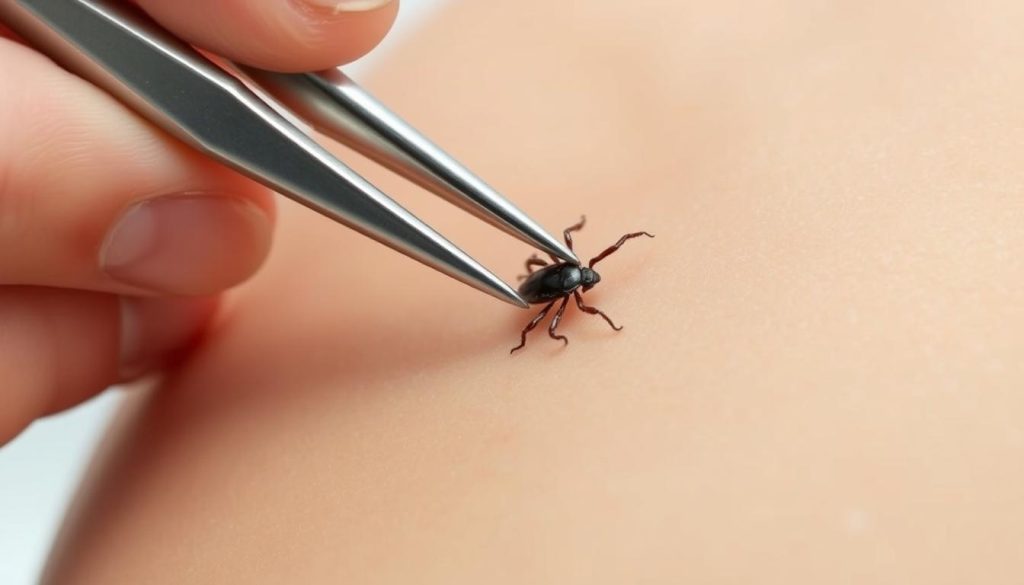When a tick bites you, it’s important to remove it correctly. This is not just for your comfort but also to avoid health problems. If you don’t remove the tick head properly, you could get sick or even infected.
This guide will show you how to remove a tick head safely and quickly. By following these steps, you can avoid any complications and keep yourself healthy.
Understanding Tick Anatomy and the Risks of Improper Removal
Learning about tick anatomy is key to removing them safely. Ticks are small arachnids that can spread diseases to humans and animals. Their mouthparts are important for attaching to hosts, making removal careful.
Improper tick removal can leave parts of the tick in your skin. This raises the risk of infection. Knowing about the tick’s head and feeding tube helps use safe removal methods.
Understanding tick biology is also important. It helps us know their lifecycle and behavior. This knowledge is vital for avoiding tick dangers all year, not just during tick season.
| Feature | Description | Implications for Removal |
|---|---|---|
| Capitulum | Contains mouthparts used for feeding | Must be fully removed to avoid skin irritation and infection |
| Hypostome | Barbed part that anchors the tick into the skin | Must be carefully extracted with precise tools to prevent breakage and residual parts |
| Palps | Help position the hypostome during feeding | Ideal point of grip for removal tools to latch without squeezing the tick’s body |
Effective tick removal needs the right technique and knowledge of tick anatomy. Removing the whole tick, including mouthparts, lowers infection risk. This is done without causing more harm to the area.
Essential Tools for Tick Head Removal
Learning how to remove tick heads safely is important. We’ll look at professional tools and some household items that work too.
Choosing the Right Tick Removal Tool
Choosing the right tool is key to safely remove tick head from your skin. Tools made for this job are precise and safe. They grab the tick without squeezing it, reducing infection risk.
There are many tick removal tools out there. Tweezers and special hooks are popular. They help remove ticks safely from people and pets.
Alternative Household Items for Tick Head Extraction
When you don’t have special tools, some household items can help. But, they’re not the best. Make sure to remove the tick’s head completely to avoid infections.
- Tweezers: Use fine-tipped tweezers to grab the tick near the skin.
- String: Use thread or dental floss to remove the tick. But be careful not to leave the tick’s mouthparts in.
- Credit Card: Use a credit card’s edge to slide under the tick and push it away.
But, for the best results, get a tick removal tool made for this job.
Having the right tools and knowledge helps you deal with ticks safely and effectively.
| Tool Type | Effectiveness | Use Case |
|---|---|---|
| Specialized Tick Removal Tool | High | Best for all types of ticks and scenarios |
| Fine-Tipped Tweezers | Medium to High | Suitable for larger ticks |
| Household Tweezers | Low to Medium | Only if no other options available |
| String or Dental Floss | Low | Emergency situations; not recommended |
| Credit Card | Low | Emergency tool; minimal effectiveness |
Preparation Steps Before Attempting to Remove a Tick Head
Before you try to remove a tick head, it’s key to get the area ready. This helps avoid infections and boosts tick prevention. These steps keep you safe and make the process easier, reducing the chance of spreading tick-borne diseases.
Cleaning the Affected Area
Begin by washing the area around the tick bite with soapy water or an antiseptic wipe. This is essential to remove any dirt that could get into the wound when the tick’s head is removed. Be gentle to prevent the tick from releasing more bacteria into your blood.
Reducing the Risk of Infection
Next, apply a bit of antiseptic solution or cream to the area. This step helps prevent infection and is part of a good tick prevention plan. Putting a sterile bandage over the area until you remove the tick head also helps keep it clean.
How to Remove the Tick Head Safely and Quickly
Dealing with a tick head stuck in your skin is uncomfortable and risky. It’s important to find the best way to remove the tick head to avoid infections. Here’s a step-by-step guide to safely and quickly remove a tick head.
- Step 1: Use fine-tipped tweezers to grasp the tick as close to the skin’s surface as possible.
- Step 2: Pull upward with steady, even pressure. Do not twist or jerk the tick; this can cause the mouth-parts to break off and remain in the skin.
- Step 3: After removing the tick, thoroughly clean the bite area and your hands with rubbing alcohol or soap and water.
- Step 4: Dispose of a live tick by submersing it in alcohol, placing it in a sealed bag/container, wrapping it tightly in tape, or flushing it down the toilet.
- Step 5: Follow up with seeking medical advice if the tick head couldn’t be completely removed, or if an infection occurs.
The best way to remove tick head involves the right tool and technique. This ensures no tick parts are left behind. This method works for both humans and pets.
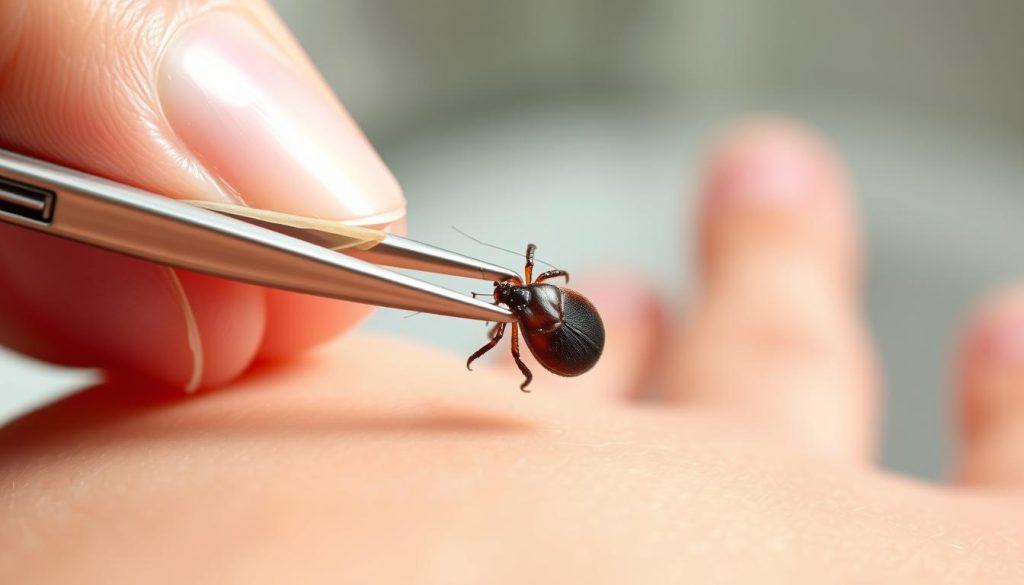
Removing tick heads quickly helps prevent diseases. Keep the area clean and watch for infection signs. If you notice any unusual symptoms after removing a tick, see a doctor.
Tick Head Removal Methods for Different Scenarios
Removing a tick head from skin needs a special approach for safety and efficiency. The method varies between humans and pets. This shows the importance of using the right technique for each case.
Removing Tick Head from Human Skin
When removing a tick from human skin, be careful to avoid leaving parts behind. This can lead to infection. Use fine-tipped tweezers to grab the tick as close to the skin as you can. Pull upward with steady, even pressure.
Avoid twisting or jerking the tick. This can cause parts to break off and stay in the skin. Clean the bite area and your hands with rubbing alcohol, iodine scrub, or soap and water after removing the tick.
Extracting Tick Head from Pets
Removing a tick from a pet needs care and gentleness. It’s also important to keep the pet calm and cooperative. Regularly check your pet after they’ve been outside, as ticks are common in grassy or wooded areas.
If you find a tick, use the same careful pulling method without twisting. After removing the tick, see a vet if any part stays in the skin or if you notice signs of infection or illness.
Both methods aim to reduce discomfort and prevent infection. They highlight the need for the right technique and care after removal. Whether it’s a human or a pet, staying calm and taking the right steps can help manage these situations well.
Aftercare: How to Treat the Skin Following Tick Head Removal
After removing the tick head, it’s important to take care of the bite site. This ensures the area heals well and prevents infection. Proper aftercare is key to avoiding problems.
Disinfecting the Bite Site
Cleaning the tick bite area is vital to avoid infection. Wash it with soap and water, then use an antiseptic. Isopropyl alcohol or iodine-based cleaners are good choices. They fight off bacteria from the tick.
Monitoring for Signs of Tick-borne Diseases
Keep an eye on the bite site for signs of tick-borne diseases. Watch for rashes, fever, tiredness, and joint pain. If you notice any, see a doctor right away. Early treatment is important.
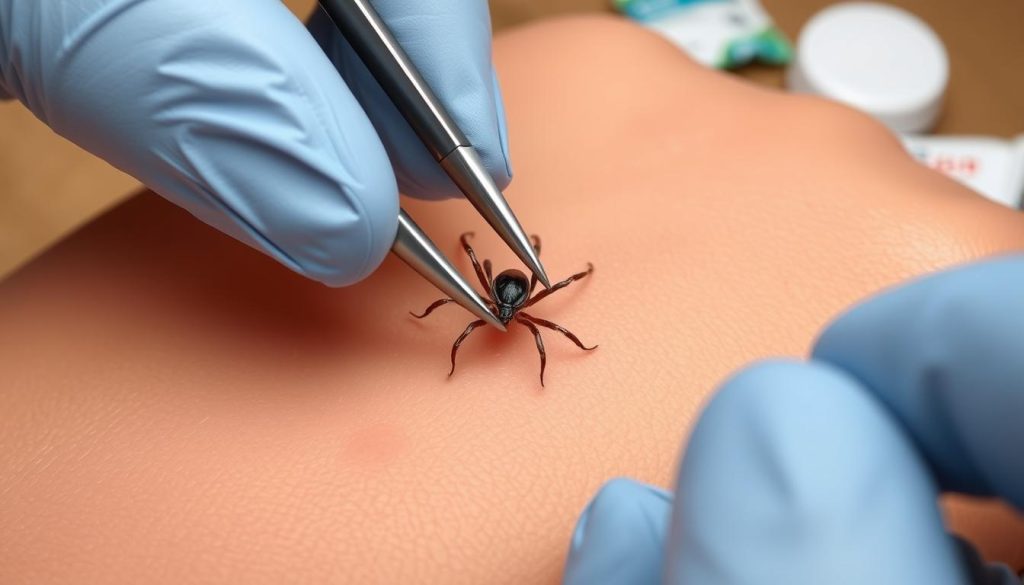
Good aftercare means cleaning and watching the bite area closely. Following these steps can help avoid tick bite complications.
Identifying When to Seek Medical Attention After Tick Removal
After removing a tick, it’s important to watch for any signs of trouble. Not every tick bite needs a doctor’s visit. But, some symptoms mean you should see a doctor right away to avoid bigger health problems.
Look out for fever, chills, tiredness, muscle pain, swollen lymph nodes, and headaches. Some symptoms are more urgent and need quick medical help.
- Development of a rash, like a bull’s-eye, around the tick bite.
- Persistent headache or facial paralysis.
- Difficulties in breathing or chest pain.
- Heart palpitations or an irregular heartbeat.
- Arthritis with severe joint pain and swelling.
- Increase in the redness or oozing at the bite site.
These signs might mean you have Lyme disease, Rocky Mountain spotted fever, or another serious tick-borne illness. Getting medical help fast is key to avoid serious health risks.
If you or someone you know has these symptoms after tick removal, see a doctor. This can help lower the risk of infection and other serious issues. Early treatment can make a big difference in fighting tick-borne diseases.
Even if most tick bites don’t cause disease, staying alert is important for your health after a tick is removed. If you’re unsure, it’s safer to get medical advice.
Proactive Measures: Tick Bite Prevention Tips
Going outside, like into woods or grass, means you need to protect yourself from ticks. Knowing how to prevent tick bites can help keep you safe from diseases they carry.
Effective Use of Repellents
Using tick repellents is key to staying safe. DEET, picaridin, or IR3535 are good choices. Always follow the instructions on how to apply and reapply, like after swimming or sweating a lot.
- Apply repellent to exposed skin and clothing.
- Avoid contact with eyes, mouth, and open cuts.
- Use enough repellent to cover exposed areas but do not over-apply.
Appropriate Clothing Choices in Tick-Prone Areas
What you wear matters when you’re in tick areas. Wear light colors so you can see ticks easily. Long sleeves, pants, and hats help too. Treat your clothes with permethrin for extra protection.
- Opt for tightly woven fabrics that make it hard for ticks to bite through.
- Pre-treat outdoor gear and clothing with permethrin.
- Perform regular tick checks after being in tick-infested areas.
For more detailed insights on reducing risks in specific environments, consider browsing this useful guide on tick prevention. Key Strategies for Outdoor Safety.
| Prevention Method | Description | Effectiveness |
|---|---|---|
| Use of Repellents | Repellents containing DEET, picaridin, or IR3535 | High |
| Clothing Choices | Light-colored, long sleeves and pants, permethrin-treated | Medium to High |
| Environmental Awareness | Avoid bushy, wooded areas during peak tick activity months | Variable |

Tick Removal Myths Debunked
When we talk about removing tick heads, many myths can be harmful. It’s important to know the truth to keep everyone safe. Here, we’ll clear up some common myths about removing tick heads.
Myth 1: Heat or substances like nail polish and petroleum jelly will make the tick fall off. But, these methods can actually make the tick more likely to spread diseases like Lyme disease.
Myth 2: Twisting the tick during removal is better. But, this can break the tick’s body and leave the head in your skin. This can lead to infections.
Myth 3: It’s safe to pull the tick off with your bare hands. But, using your fingers without the right tools and cleanliness can cause more problems. It can even spread tick-borne diseases.
| Myth | Fact |
|---|---|
| It’s safe to crush a tick once removed. | Crushing a tick may release harmful pathogens. Dispose of it by submerging in alcohol or a sealed bag. |
| Use matches or cigarettes to detach ticks. | The correct method involves using fine-tipped tweezers to grasp the tick close to the skin’s surface and pulling upward with steady, even pressure. |
| All ticks carry Lyme disease. | Not all ticks carry pathogens, and the transmission of disease depends on the tick species, how long it’s been attached, and other factors. |
It’s key to follow proven tick head removal methods and advice from health and wildlife experts. This ensures safe and effective tick removal for everyone.
Common Mistakes to Avoid During Tick Head Removal
Trying to safely remove a tick head can go wrong if you make common mistakes. These errors can make the process less safe and less effective. It’s important to know what these mistakes are to avoid them.
Why Squeezing the Tick Could Be Dangerous
Squeezing a tick is a big mistake. It can push the tick’s stomach contents back into you. This can lead to serious diseases like Lyme disease. Always use fine-tipped tweezers to pull the tick out slowly and carefully.
The Problem with Home Remedies
Home remedies like petroleum jelly or heat might seem like a good idea. But they don’t work well and can be harmful. They can let the tick stay longer, increasing the chance of disease. Stick to using tools to remove the tick head safely.
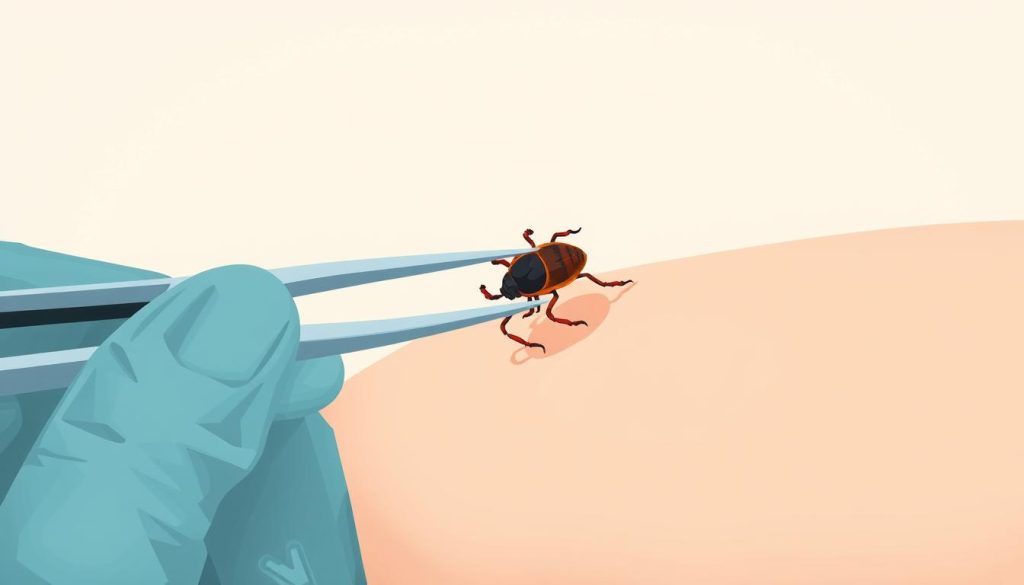
Recommended Tick Removal Products and Where to Find Them
Keeping yourself and your pets safe from ticks is very important. This guide will show you the best tick removal tool options. It will also teach you how to remove the tick head safely to avoid infections or irritation.
Discovering a tick on your skin can be scary. But, having a good tick removal tool can make it less stressful. Here, we compare top tick removal tools, their uses, and where to buy them.
| Product Name | Type | Best For | Purchase Location |
|---|---|---|---|
| Tick Twister | Hook | People and Pets | Online Retailers & Pet Stores |
| Ticked Off Spoon | Spoon | Quick removal | Pharmacies & Outdoor Supplies |
| Tackle Tick Forceps | Forceps | Precision grip | Medical Supplies & Online Shops |
Each tick removal tool comes with its own set of instructions. It’s important to follow these to remove ticks safely and learn how to remove the tick head if it stays in the skin. Doing so helps prevent tick-borne diseases and keeps you healthy.
- The Tick Twister removes ticks without squeezing them, lowering infection risk.
- The Ticked Off Spoon is easy to use, great for quick and safe removal on kids and pets.
- Tackle Tick Forceps are perfect for removing ticks from tight spots and hairy areas.
Having the right tools and knowledge is key to fighting tick bites. Remember, quickly and safely removing a tick from your skin or your pet’s skin is vital to avoid serious health problems.
Real-Life Examples of Safe Tick Head Removal
Real stories from people who have safely removed tick heads can give us hope and useful tips. These stories show how important it is to remove ticks correctly to avoid infections.
Success Stories from Pet Owners
Pet owners often share how they safely took ticks off their pets. They talk about the need to handle the tick gently to remove it completely.
- Using fine-tipped tweezers to grasp the tick as close to the skin’s surface as possible.
- Pulling upward with steady, even pressure without twisting or jerking the tick.
- Cleaning the bite area and tweezers with rubbing alcohol or soap and water after removal.
First-hand Accounts of Tick Encounters in the Wild
People who love the outdoors often deal with ticks. Their stories teach us how to remove tick heads safely.
- Recognizing the need to remove the tick head quickly to lower disease risk.
- Using a skin-safe tick removal device to get ticks out without hurting them.
- Getting medical help if unsure about removing the tick head or if symptoms show up later.
| Method Used | Context | Outcome |
|---|---|---|
| Tick removal tweezers | Home pet care | Complete removal without infection |
| Tick removal card | Hiking in woodlands | Success without leaving any parts in the skin |
| Pointed tweezers | Backyard activity | Effective extraction and swift healing |
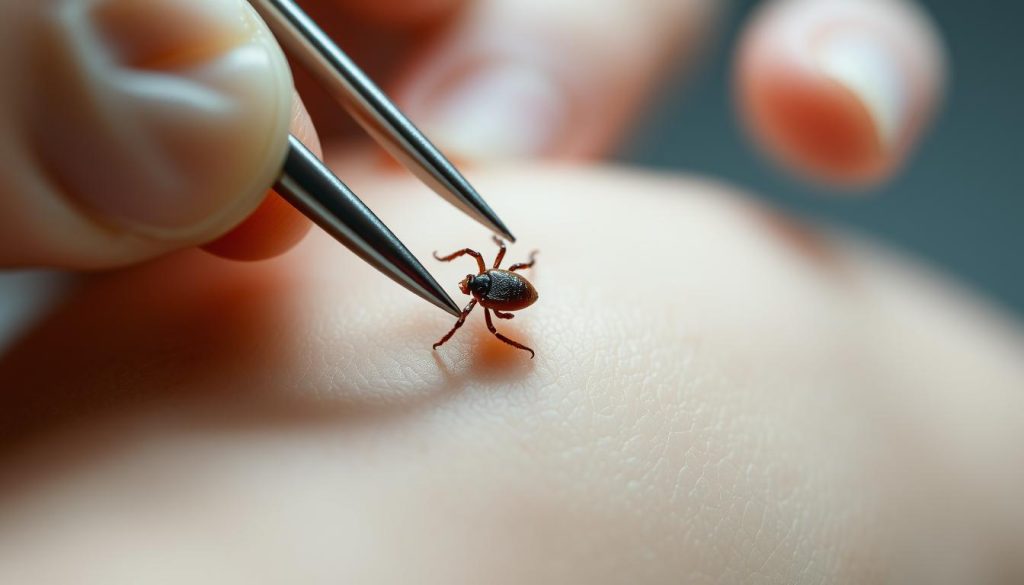
Best Way to Remove Tick Head: A Step-By-Step Visual Guide
Dealing with a tick bite requires removing the tick head carefully. This is key for quick relief and to avoid infections. Our guide shows you how to remove a tick head step by step. It includes visual aids to help you follow along easily.
Begin by using fine-tipped tweezers. The guide teaches you to grab the tick close to your skin. This is the first step in removing the tick head correctly. Make sure to pull the tick straight up without twisting to avoid leaving parts behind.
After removing the tick head, clean the bite area and tweezers well. This step is vital to avoid infections. The guide shows how to disinfect properly and use antiseptic. It also tells you how to dispose of the tick and watch for signs of Lyme disease. Following these steps ensures you remove the tick head safely and effectively.
FAQ
Q: What is the proper technique for removing a tick head?
A: To remove a tick head, use fine-tipped tweezers to grab the tick close to your skin. Pull it up slowly and steadily. Don’t twist or jerk the tick, as this can leave parts behind.
Q: Can I remove a tick head with household items if I don’t have a tick removal tool?
A: Fine-tipped tweezers can work if you don’t have a tick removal tool. Make sure to clean them before and after use. Avoid using blunt tweezers or other items that might squeeze the tick and increase infection risk.
Q: What should I do to prepare for tick head removal?
A: Clean the area around the tick with rubbing alcohol or soap and water. Wear gloves to protect yourself. Have a clean container ready to throw away the tick after removal.
Q: What are the key steps to safely and quickly remove a tick head from human skin?
A: Use fine-tipped tweezers to grip the tick near your skin without squeezing it. Pull up slowly and steadily. Then, clean the bite area and wash your hands well. Dispose of the tick in alcohol or a sealed bag.
Q: How should I remove a tick head from my pet?
A: Use fine-tipped tweezers to gently pull the tick out of your pet’s skin. Keep your pet calm and clean the bite site with pet-safe antiseptic. If unsure, consult a vet.
Q: After tick head removal, how do I treat the skin?
A: Clean the bite site with rubbing alcohol or antiseptic cream. Watch the area for signs of infection or rash for several days. If symptoms are unusual, see a healthcare provider.
Q: What symptoms indicate the need for medical attention after tick removal?
A: Seek medical help if you have a rash, fever, fatigue, joint pain, or swollen lymph nodes after a tick bite. These could be signs of tick-borne diseases.
Q: How can I prevent tick bites?
A: Use insect repellent with at least 20% DEET. Wear long sleeves and pants in wooded areas. Tuck pants into socks. Check for ticks after outdoor activities and shower soon after being outside.
Q: What are some myths about tick head removal?
A: Myths include using nail polish, petroleum jelly, or heat to remove ticks. These methods don’t work and can spread disease. The best method is to remove the tick with tweezers.
Q: What common mistakes should I avoid during tick head removal?
A: Don’t squeeze or crush the tick’s body, as it can inject harmful fluids. Also, avoid twisting or jerking the tick, as this can leave the head in your skin.
Q: Where can I find reliable tick removal products?
A: You can find tick removal products, like fine-tipped tweezers or tick removal tools, at drugstores, pet supply stores, outdoor stores, or online.
Q: Are there any successful real-life stories of tick head removal available?
A: Yes, many people and pet owners have shared their success stories of tick head removal. They talk about their methods and the importance of proper technique and quick action.
Q: Is there a visual guide for the best way to remove a tick head?
A: Yes, there are step-by-step visual guides online from reputable health organizations. They include detailed images or videos to show the best ways to remove a tick head.












